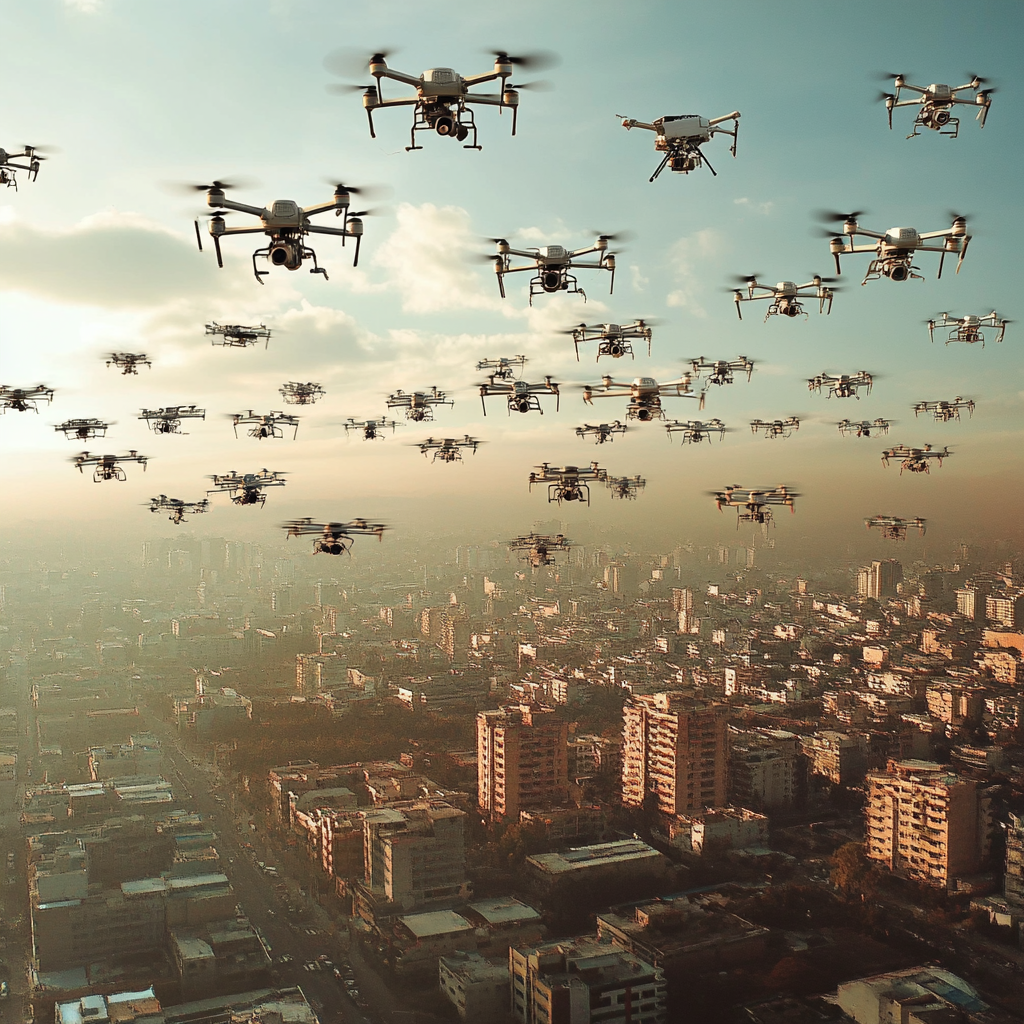Introduction
As unmanned aerial vehicles (UAVs) or drones become increasingly prevalent in both military and civilian applications, the need for robust and intelligent Identification Friend or Foe (IFF) systems has never been more critical. At Decent Cybersecurity, we’re at the forefront of developing cutting-edge solutions to address this challenge. Our innovative DroneCrypt IFF system integrates artificial intelligence (AI) to provide advanced threat detection capabilities, setting a new standard in drone security.
This article explores the role of AI in enhancing threat detection for drone IFF systems, highlighting the benefits, challenges, and future prospects of this technology.
The Need for AI in Drone IFF
Traditional IFF systems, while effective in many scenarios, face increasing challenges in the complex and rapidly evolving landscape of drone operations:
- Sophisticated Spoofing Attacks: Adversaries are developing more advanced techniques to mimic legitimate IFF signals.
- Dynamic Threat Landscape: The nature of threats is constantly changing, requiring adaptive defense mechanisms.
- Information Overload: As drone usage increases, IFF systems must process and analyze vast amounts of data in real-time.
- Autonomous Operations: The growth of autonomous drone swarms necessitates more intelligent and responsive IFF systems.
AI, with its ability to learn, adapt, and make rapid decisions based on complex data patterns, offers a powerful solution to these challenges.
How AI Enhances Drone IFF
1. Pattern Recognition and Anomaly Detection
AI algorithms, particularly machine learning models, excel at identifying patterns and detecting anomalies in large datasets. In the context of drone IFF, this capability allows for:
- Behavioral Analysis: AI can learn the typical behavior patterns of friendly drones and flag any deviations that might indicate a threat.
- Signal Analysis: Machine learning models can analyze IFF signals to detect subtle inconsistencies that might be indicative of spoofing attempts.
Our DroneCrypt IFF system employs an ensemble of Isolation Forest and Long Short-Term Memory (LSTM) neural networks for this purpose, achieving a false positive rate of less than 0.01% and a false negative rate of less than 0.001%.
2. Real-Time Threat Assessment
AI enables IFF systems to perform rapid, real-time threat assessments by:
- Contextual Analysis: Considering factors such as drone location, mission parameters, and current threat levels to evaluate potential risks.
- Predictive Modeling: Using historical data and current trends to anticipate potential threats before they materialize.
The AI subsystem in DroneCrypt IFF processes each transaction in less than 10ms, ensuring swift response to potential threats.
3. Adaptive Security Protocols
AI-powered IFF systems can adapt their security protocols in response to evolving threats:
- Dynamic Rule Generation: AI can create and update security rules based on new threat patterns it observes.
- Automated Response: In high-threat situations, AI can initiate pre-defined security protocols without human intervention, reducing response times.
4. Swarm Intelligence Integration
For scenarios involving drone swarms, AI can enhance IFF capabilities by:
- Collective Threat Assessment: Aggregating and analyzing data from multiple drones to improve threat detection accuracy.
- Swarm Behavior Optimization: Adjusting the behavior of the entire swarm based on detected threats to enhance overall security.
The DroneCrypt IFF Advantage
At Decent Cybersecurity, our DroneCrypt IFF system represents the state-of-the-art in AI-powered threat detection for drone identification. Key features include:
- Advanced AI Model: Our ensemble of Isolation Forest and LSTM neural networks provides robust anomaly detection capabilities.
- Rapid Processing: With a processing time of less than 10ms per transaction, DroneCrypt IFF offers near-instantaneous threat detection.
- High Accuracy: Our system achieves exceptionally low false positive (< 0.01%) and false negative (< 0.001%) rates.
- Comprehensive Analysis: DroneCrypt IFF analyzes various features including IFF query patterns, response times, geographical inconsistencies, and cryptographic anomalies.
By integrating AI with other advanced technologies such as quantum-resistant cryptography and blockchain, DroneCrypt IFF offers a comprehensive, future-proof solution for drone security.
Challenges and Solutions
While AI offers significant benefits for drone IFF, it also presents certain challenges:
1. Data Quality and Quantity
Challenge: AI models require large amounts of high-quality data for training and operation.
Solution: DroneCrypt IFF utilizes advanced data augmentation techniques and synthetic data generation to enhance our training datasets. We also implement rigorous data validation processes to ensure the quality of incoming data.
2. Explainability and Transparency
Challenge: The decision-making processes of complex AI models can be difficult to interpret, which is crucial in security applications.
Solution: We employ explainable AI techniques, such as SHAP (SHapley Additive exPlanations) values, to provide clear insights into our model’s decisions, ensuring transparency and auditability.
3. Adversarial Attacks
Challenge: AI models themselves can be targets of sophisticated attacks aimed at manipulating their outputs.
Solution: DroneCrypt IFF incorporates adversarial training techniques and regularly updated defense mechanisms to protect our AI models against potential attacks.
Future Prospects
The field of AI-powered threat detection for drone IFF is rapidly evolving. At Decent Cybersecurity, we’re actively researching and developing next-generation capabilities:
- Quantum Machine Learning: Exploring the potential of quantum computing to enhance the speed and capability of our AI models.
- Federated Learning: Developing techniques to train AI models across multiple drones without compromising data privacy.
- Neuromorphic Computing: Investigating brain-inspired computing architectures for more efficient and adaptive AI processing in resource-constrained drone environments.
Conclusion
AI-powered threat detection represents a significant leap forward in drone IFF technology. By enabling more accurate, adaptive, and intelligent threat detection, AI enhances the security and reliability of drone operations across various sectors.
At Decent Cybersecurity, our DroneCrypt IFF system exemplifies the potential of AI in this domain. We remain committed to pushing the boundaries of what’s possible in drone security, continually innovating to stay ahead of emerging threats and ensure the safe integration of drones into our skies.
As the drone ecosystem continues to expand and evolve, AI-powered IFF systems will play an increasingly crucial role in maintaining security, enabling new applications, and fostering public trust in drone technology.
References
[1] Brust, M. R., Danoy, G., Bouvry, P., Gashi, D., Pathak, H., & Gonçalves, M. P. (2017). Defending against intrusion of malicious UAVs with networked UAV defense swarms. 2017 IEEE 42nd Conference on Local Computer Networks Workshops (LCN Workshops), 103-111.
[2] Honkela, K., Javed, A., & Ahmad, N. (2023). Robust drone identification systems using deep learning and blockchain. IEEE Transactions on Aerospace and Electronic Systems, 59(3), 1585-1599.
[3] Li, Y., Cao, H., & Wang, X. (2022). AI-enabled UAV authentication: A survey and open issues. IEEE Internet of Things Journal, 9(17), 15733-15754.
[4] Ramos, V., Rodriguez-Fernandez, V., & Alfaro-Cid, E. (2021). AI-based defensive swarms for protecting critical infrastructure against drone attacks. Engineering Applications of Artificial Intelligence, 102, 104287.
[5] Zhang, L., Ding, Z., & Han, Z. (2020). Intelligent security for Internet-of-Drones: A survey. IEEE Wireless Communications, 27(5), 22-28.







